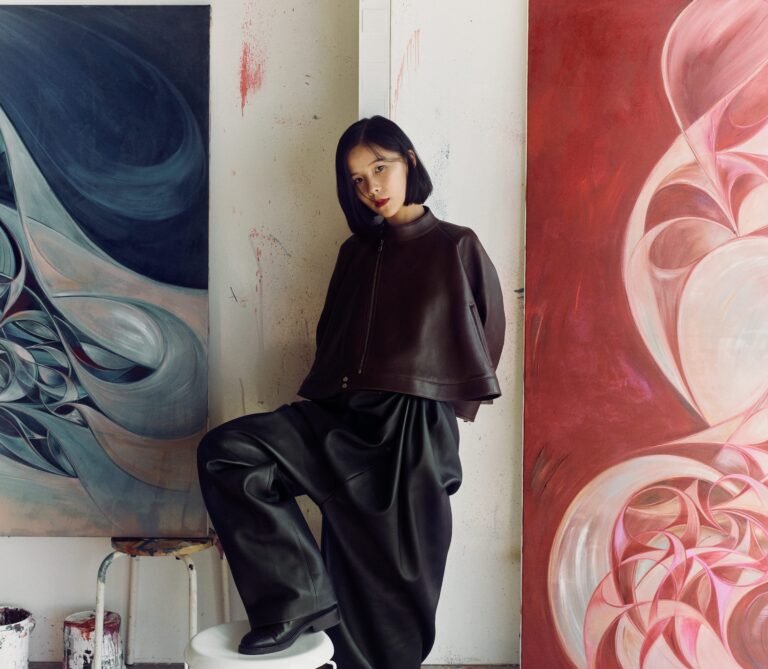
Fierce, untamed painterly gestures surge and reverse, folding into the swirling entanglements of artist Yuan Fang’s abstraction. They expand toward the infinite, then coagulate into energetic nuclei that implode into mass before breaking apart again in multiplying flame-like or tidal movements that echo the expansive and disaggregative forces binding all matter in a perpetual cycle of generation, transformation, decay and rebirth.
In just a few years, Fang has become one of the most sought-after names in emerging abstraction, first capturing collectors’ attention in her native China and soon after across the globe. Her warm whirlwind of hand-touched gestures feels both psychologically and physically participatory, evoking, beyond figuration, movements and bodily expressions that release an overwhelming vital energy. That energy resonated deeply with audiences who, after the long period of restriction during the pandemic, yearned for renewed physical connection and sensation. Interest in her work surged during that time and has endured since. While her auction record remains $88,900, achieved by Expanse (mask) at Phillips New York in March 2023, her results have stayed consistent—particularly in Hong Kong—showing how her compelling approach to abstraction continues to engage collectors beyond passing trends. Last year, the artist joined Skarstedt, further cementing her career with strong international representation.


The new body of paintings Fang is currently presenting at Skarstedt Chelsea marks a shift. They carry a different intensity born from the visceral, hard-won awareness of the limits in that perpetual conflict between body and spirit, the transience of flesh and the infinite potential of the mind. That awareness emerges most starkly when confronted with the body’s vulnerability—something Fang faced this year after learning she had cancer. The result is a series of emotionally and psychologically charged works that stage a strenuous struggle for resistance and resilience in the face of the entropy that rules over our bodies and our individual fate.
Fang’s approach to the canvas is deeply intuitive, she explains when we meet in her studio. The vibrant, freshly finished works—spread in a circle around the room—were still pulsing with energy before leaving for the gallery. For Fang, painting is not about premeditation but about transferring and channeling forces through a constant exchange as she navigates the push and pull of the surface. “I think my process is very intuitive because I don’t really use sketches,” she tells Observer. “For me, painting is almost like an accident; you discover what it should be as you work on it. The process is about finding the piece along the way. I like to leave space for the unknown to take over.”
Every one of Fang’s paintings begins differently. She usually starts with a basic flow or a structure she wants to achieve, then moves into the line work. “From there, I add more layers, and it becomes this ongoing process of adding and erasing,” she explains. “There’s a lot of building up and cutting back in each painting.”
Although the expansive movements of paint seem capable of evolving endlessly beyond any structure, they are anchored by a graphic foundation that guides and orients their flow rather than corrects or contains it. In this process, almost like automatic writing, there’s an attempt to capture invisible forces and the violence of the sensations they spark. Fang is open about the fact that these paintings are far more visceral than her earlier work, born of a direct confrontation with the body’s limits and representation and a fierce fight for its survival.
“I would describe these paintings as deeply visceral: the abstract forms and shapes often allude to twisted or fluid versions of the human body, or to states of emotion,” she says. “I’m interested in how these shapes and layers interact, creating chaotic and turbulent relationships. For me, this becomes a metaphor for the human condition—and for my own experience of navigating life in this world.”


Switching from acrylic to oil, with its sensuous density and capacity for deep layering, was instrumental for Fang in achieving a new range of sensorial and psychological projection—both of the self and the collective—she wanted her paintings to convey. The longer one looks at these works, the more they seem to shift and breathe, becoming magmatic, living matter animated with a depth and presence she could never have reached with the taut surface of acrylic on canvas.
“When I was younger, I wanted everything to happen quickly and intensely. That’s how I would describe my early acrylic paintings,” Fang reflects. She never attended art school or spent time drawing from models; in the beginning, she was simply experimenting, doing many things at once. Acrylic matched that urgency, drying quickly and aligning with her need to express and transfer energy to the canvas. “As I’ve gotten more experienced, I’ve started to value having more time to think about each layer and what I want to do next. I’ve also grown to appreciate softer rendering, because acrylic’s layers can feel harsh or rough. That softer approach feels more subtle, and for me, it creates a very different kind of presence in the work.”
Yet all the marks seem to curl off the canvas in sweeping arcs, tracing a curvilinear, voluted evolution that finds countless parallels in the biological world. Ribbon-like forms overlap and weave through each other, generating a dynamic rhythm across the surface.
These curvilinear gestures have become the anchor of Fang’s visual lexicon, a constant carried over from her earlier series. For Fang, the curves embody the female body and emotions. “Compared to men, women often express themselves in ways that are more indirect, yet still incredibly powerful,” she reflects.
Her intention is to convey that while women may not always possess greater physical strength, they hold emotional, psychological and spiritual power that grounds them and makes them more resilient. “I want my paintings to embody that—strong, complex and full of depth.” In their muscular tension, resolved in a harmonious dance, these paintings become metaphors for female strength.
Even in her choice of colors, Fang has become intentionally more visceral, deliberately evoking the reality of blood and flesh. Her palette moves through rich, saturated registers of predominantly crimsons, burgundies and deep plums, punctuated at times by flashes of pink and coral before plunging into the depths of blue or the fertile, electric charge of a deep green in just two of the works.


For Fang, the canvas becomes a stage for representation that moves beyond the logic of sensation, seeking instead to channel both the generative and destructive violence of matter. The result is an unrestrained eruption into a sensorial and emotional reality, converging into image and symbol. Here, Fang works with a visual code beyond language that confronts the most primordial human act of affirmation: leaving a mark, drawing a curve that intersects another until it becomes a symbol. It is a meaning that both translates and transcends the physical and sensory reality of perception, opening into the symbolic.
Francis Bacon once described his paintings as works that “hit directly the nervous system.” The same could be said of Fang’s seemingly uncontainable sequences of plasmatic fields that open infinite narrative possibilities, only to land momentarily in the “matter of fact” before slipping away. The limits of sensation are surpassed in multiple directions, but in the end, the work still resists chaos—sometimes hysterically, sometimes with deep calibration—until form precipitates again. As with human existence itself, it is an accidental presence within the vastness of the cosmos.
This tension between order and chaos becomes even more compelling when one considers Fang’s use of empty space in these new works. It immediately links her, as she acknowledges, to the long tradition of Chinese painting, where emptiness is not absence but a space of evocation—an opening where the invisible and sensually unreachable emerge, revealing inner and outer truths of both the body and the flux of forces and processes that traverse it.
In this constant oscillation between form and void, movement and stillness, paint transforms into waves or organic structures in motion. The invisible—the qi, the vital force—manifests through abstraction, in the image of a body contending with its own material presence and the potentially infinite expansiveness of the mind. It is within this space that Fang stages a boundless interplay between embodiment and disembodiment, suggestive of a fluid reality where being, feeling and experiencing are all part of a broader entanglement.
At the same time, as Fang reflects, the empty space around these entanglements is precisely what allows their presence to intensify. “Leaving more empty space makes the central figure—or whatever you want to call it—feel stronger and more pronounced,” she observes.
For Fang, this idea of void and restraint also resonates with her current condition. “I’ve been undergoing medical treatment, which makes me tire more easily and means I don’t have the same physical strength I used to,” she admits. “Because of that, I wanted the paintings to feel more restrained—holding back rather than pushing with full force.”
One painting is a particularly strong meditation on this psychosomatic state. Dominated by deep blues and vivid reds, its surface is filled with interlocking curved shapes that resemble flame-like tongues and layered petals, forming a dense, almost vortex-like structure. The interplay of cool and warm colors heightens the tension, but at its heart is an intense, energetic core—pulsing like a heart—its red light radiating outward. This heat seems to expand through the work, resisting the cooling tides of blue.
“I think of it as a fire,” Fang says as we stand before the painting. “The center is the chest, radiating light that seems to illuminate the whole canvas. But for me, it’s also something deadly, like cancer cells growing out of the chest. I wanted to capture that duality—the idea that beauty can carry brutality within it. That tension between allure and danger is what makes this piece feel so powerful to me.”
In another work, dominated by vibrant greens and painterly tides of germination, Fang extends this meditation beyond the individual body to reconnect with nature’s regenerative potential for healing and rebirth—once one reenters those rhythms. The painting unfolds with a rhizomatic energy: lively green expanses branch outward, claiming their generative presence from tides of blood-red, merging in hope for new cycles. This piece, she explains, was inspired by a recent trip Upstate, where she found solace and renewal in nature. “It made me think about plants and the human body as two kinds of living forms. Plants can’t speak or communicate with us in the way people do, but they’re still living beings that grow and change,” Fang reflects. “That quiet, ongoing growth fascinates me.”


Here, the human presence is either diminished or amplified—expanded into its potential to weave new entanglements and generate sequences of interaction with the external world, the same forces that can make existence not only more meaningful but also more soulful. Fang grew up in Shenzhen, a major city in China, but one largely without historical continuity, its past erased by the relentless pace of the country’s accelerated modernization and industrialization. She acknowledges she is not the kind of Chinese person who grew up practicing Buddhism or other traditional customs, yet she feels there is still an indirect influence in her work. “There’s a Buddhist saying about how everything is uncertain, and I believe that idea has become my ultimate life philosophy. It’s something that also comes through very directly in my work.”
In this body of work, she unleashes painting’s full potential to metaphorically and symbolically suggest the body as a complex entity caught in an unsettled tension between flesh and psyche. Gripped by this strain, her splaying, swirling shapes twist into sudden twitches and convulsions, pressing against the limits of both body and mind to break into new conceptions of what they might be. The body is evoked here as an event—a site where facts happen, where organs process substance, where life pulses, or where silent toxicity corrodes from within, imperceptibly. Yet it remains a living matter, pulsing and fighting, channeling every last reserve into thriving and asserting its resistance.
Yuan Fang’s “Spaying” opened at Skarsdet on September 4, 2025.


More in Artists






